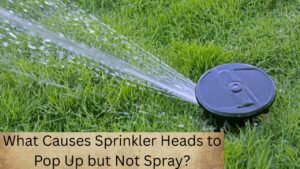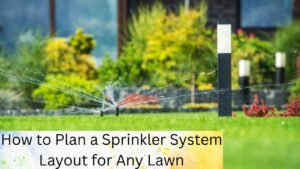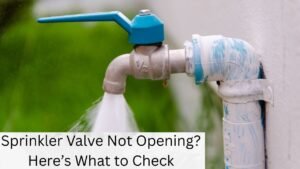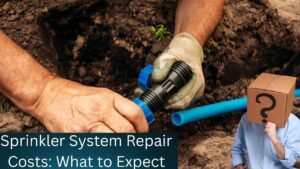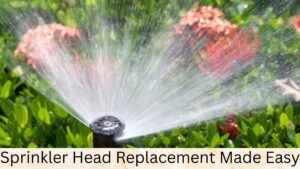Is your sprinkler system barely trickling water instead of providing that refreshing spray you expect? Low water pressure in your sprinkler system can be a frustrating issue that disrupts your yard’s health, leaving it dry, unevenly watered, or even brown. Luckily, you don’t have to call a professional just yet – many of the causes of low water pressure are easy to diagnose and fix yourself.
This guide will walk you through the common causes of low water pressure in sprinkler systems and provide clear, actionable solutions. Whether you’re dealing with clogged pipes, pressure regulator issues, or leaks, we’ve got you covered. You’ll gain the knowledge to troubleshoot problems on your own, save money, and get your lawn looking its best again.

Why Is My Sprinkler System Not Producing Enough Water?
When your sprinkler system has low pressure, the water flow becomes weak or uneven. Here are the primary causes of low water pressure:
- Closed or Faulty Valves: A valve that is partially closed or malfunctioning can restrict the flow of water.
- Clogged Sprinkler Heads: Dirt, debris, or mineral buildup can block water from coming out of the sprinkler heads.
- Leaks in the System: Cracks in pipes or fittings can lead to water loss, affecting pressure.
- Pressure Regulator Issues: A malfunctioning pressure regulator might be limiting the water pressure.
- Pump Failures (for Well Systems): If you’re using well water, the pump may not be strong enough to support the sprinkler system.
How to Check and Adjust Valves for Low Pressure
One of the easiest fixes for low water pressure is checking and adjusting the valves.
- Main Water Valve: Ensure the main water shutoff valve is fully open. Sometimes, this valve gets partially closed during maintenance or repairs.
- Zone Control Valves: Each zone in your sprinkler system has a control valve. If a zone isn’t getting enough water, the valve for that zone might be closed too much. Open the valve fully to allow the proper amount of water to flow.
Visual Tip: If your system only has low pressure in specific zones, it could be an issue with the valve for that particular zone.
Troubleshooting Low Pressure in Specific Zones
If low water pressure is only affecting certain zones of your sprinkler system, follow these steps:
- Check Zone Valve: As mentioned earlier, ensure the zone valve is fully open.
- Inspect Sprinkler Heads: Sometimes, low pressure is zone-specific because one or more sprinkler heads are clogged.
- Test the GPM for the Zone: Calculate the Gallons Per Minute (GPM) for that zone. If too many sprinkler heads are using more GPM than the water supply can handle, you may need to reduce the number of heads in that zone.
How to Flush a Sprinkler System and Clear Clogs
A common cause of low pressure is debris or mineral buildup in the pipes. Flushing your system can clear these blockages.
- Pop-Up Sprinkler Systems: Turn off the water and remove the sprinkler heads. Attach a hose to the pipe and use high-pressure water to flush out the lines.
- Drip Irrigation Systems: These are more delicate, so use lower pressure when flushing. Disconnect the tubing and use a gentle stream of water to push out the debris.
Safety Tip: Wear gloves and goggles when handling high-pressure water to avoid injury.
How to Test Your Sprinkler System’s Pressure
To troubleshoot low water pressure, you’ll need a pressure gauge. Here’s how to do it:
- Choose the Right Pressure Gauge: Make sure to use a gauge that’s compatible with your system. For residential systems, gauges that measure between 30-80 PSI are ideal.
- Attach the Gauge: Connect the gauge to the main water inlet valve or to one of the sprinkler heads.
- Take the Reading: Turn on the system and read the pressure. Residential systems should have a pressure of 30-50 PSI. If the reading is too low or high, the pressure regulator might need adjustment or replacement.
Pressure Regulators: Why They Matter and How to Adjust or Replace Them
Pressure regulators help maintain the correct water pressure for your sprinkler system. If your system’s pressure is consistently too high or low, the regulator might be the issue.
- Check the Regulator: Use a pressure gauge to test the pressure. If the regulator is faulty, you’ll need to replace it.
- Adjusting the Regulator: Some regulators have an adjustment screw that allows you to increase or decrease pressure. Be cautious when making adjustments, as too much pressure can damage the system.
Understanding and Fixing Leaks in Your Sprinkler System
Leaks are a major cause of low pressure. Here’s how to find and fix them:
- Visual Clues: Look for wet spots on your lawn, pooling water, or unusually dry patches. Misting or spraying water near fittings is also a sign of a leak.
- Check for Cracks: Inspect pipes and fittings for visible cracks. Sometimes, leaks are underground, so you may need to dig up parts of the system.
- Test for Leaks: If you have low pressure and can’t find a leak visually, conduct a pressure test to identify the issue.
How Elevation Affects Water Pressure in Sprinkler Systems
The elevation of your landscape can impact how much water pressure your sprinkler system gets. If your yard is on a hill, water may not flow efficiently to all areas.
Solution: Consider installing a booster pump to increase water pressure in areas that are lower than the water source. Alternatively, adjust the sprinkler heads to compensate for low pressure in high-elevation areas.
Troubleshooting Low Pressure from Well Water Systems
If you use well water, pressure issues could be related to the pump’s capacity. A well pump may not have the power needed for multiple sprinklers at once.
- Check Pump Capacity: Make sure your well pump is powerful enough to handle your sprinkler system’s demand. If it’s undersized, you may need to replace it.
- Pump Problems: If your pump isn’t running at full capacity, it could be failing or have a blockage. Call a professional if you suspect pump failure.
The Impact of Backflow Preventers on Water Pressure
Backflow preventers are essential for keeping contaminants out of the water supply, but they can sometimes reduce pressure if improperly sized or installed.
- Check the Size: Ensure the backflow preventer is correctly sized for your system.
- Test the Pressure: If you notice a significant drop in pressure, the backflow preventer could be the culprit. Consult a professional to inspect and possibly replace it.
Sprinkler System Maintenance: How to Prevent Low Pressure Issues
Routine maintenance is key to preventing low water pressure in your sprinkler system. Here’s what you should do regularly:
- Inspect and Clean Sprinkler Heads: Clean your sprinkler heads every 3-4 months to prevent clogging from dirt and debris.
- Check for Leaks: Inspect your system for leaks at least twice a year.
- Test the Pressure: Perform a pressure test annually to ensure your system is operating at optimal levels.
- Flush the System: Flush your sprinkler system yearly to prevent mineral buildup, especially if you have hard water.
Common Tools for Diagnosing Low Pressure
Professionals use a variety of tools to diagnose and fix low pressure issues. Some common tools include:
- Pressure Gauges: Used to measure the water pressure at various points in the system.
- Pipe Locators: Used to find underground leaks.
- Flow Meters: Measure the water flow rate, helping identify zones that are over or under-performing.
Additional Resources for Troubleshooting
- Manufacturer Manuals: Your sprinkler system’s manual is an essential resource for understanding pressure settings, maintenance schedules, and troubleshooting.
- Online Calculators: Use online calculators to determine the GPM requirements for your sprinkler heads and system.
Conclusion: You Can Fix Low Water Pressure Yourself
Don’t let low water pressure ruin your lawn. By following these troubleshooting tips and regular maintenance practices, you can restore your sprinkler system to peak performance. Whether you’re dealing with valve adjustments, leaks, or clogged pipes, this guide provides all the information you need to get your sprinklers back on track.
With these tools and knowledge, you have the power to fix your sprinkler system and keep your lawn looking lush and green all season long.
